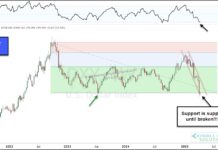That is a great question. And one that only you can answer. To some extent, your level of stock market exposure depends upon your age and risk tolerance. But it also depends on the where the economy and stock market are at in terms of the market cycle.
Let’s start by focusing on an investors age, then finish with some comments on the current market cycle.
For those who are retired or near retirement, the number one priority must be to avoid significant losses. Many investors experienced losses of 30-60% in the crash of 2000-2003 and then again in the crash of 2007-2009.
Depending on their age at the time, though, those who were still working and contributing to their 401k’s recovered over the ensuing years.
Keep in mind, though, that much of that recovery occurred because they continued to put more money in on a monthly basis. Their monthly contributions over the years 2000-2002 and/or 2007-2009 went into a market that had retreated by almost 50% from the highs. As the markets resumed their uptrend their accounts gained ground quickly.
That taught some investors that they will be fine as long as they hang in there because the markets will eventually recover and all will be fine. That may be true for those that are still 10 years or more away from retirement. They are probably at the highest salary level of their careers and are able to contribute a higher percentage of their income to their retirement nest egg. And thus have a higher level of stock market exposure. They have time and their income on their side.
However, those who are retired don’t, so they must focus on avoided significant losses.
The situation, though, for those that are retired or within a year or two of retirement is very different. They aren’t in a position to continue putting money from wages into their retirement fund for another 5 or 10 years. Instead, most of them have stopped contributions and are instead taking distributions.
The risk of financial harm is much, much greater for them if they have stock market exposure. And it is likely that they won’t be able to recover from a loss of 20%, 30% or 40%. In fact, if they take distributions of 5-7% a year to fund their lifestyle, it is virtually impossible to recover from even a 20% loss (which is often considered a ‘normal’ correction). Retirees who fail to recognize these risks may be forced to go back to work or drastically reduce their standard of living.
The strategies, processes and approach used must be different for retirees.
Since most of my clients are retired or very near retirement, I approach account management from the perspective of avoiding losses of 15-20% or more. The strategies, systems and processes that I use are designed with that in mind. And I manage the amounts allocated among stocks, bonds and cash from that perspective. In order to do so, it requires me to constantly assess the relative risks between those asset classes to determine the relative risk and reward.
The last several months I have been decreasing my allocation to both stocks and bonds and increasing cash. I have the lowest allocation to stocks since the crash in 2008. Actually, my only equity positions currently are short stocks and those are small positions. The bulk of the portfolios are in US Treasury bond ETFs like the 20+ Year Treasury Bond ETF (TLT) and the 7-10 Year Treasury Bond ETF (IEF) – i.e. spread over short to long term durations.
Sure, that means that we may miss some of this recovery in stocks, but it also means that we missed much of the big drop in stocks that happened in August. For instance, the highs in the main US stock indexes occurred in June and the decline started in earnest in the latter half of July. The trend indicator that I use signaled a downtrend in US stocks on July 2nd, 2015 and has remained in the downtrend status since then.
The economic indicators and global macro research (what is happening around the world) has also indicated that growth is slowing. When growth slows, it is harder for companies to continue to grow their revenues and their profits. That decline actually started in the 2nd quarter reporting period where revenues for the S&P 500 were down -2.1%. That trend seems to be continuing and accelerating in this quarterly earnings cycle. So far, 15% of the S&P 500 companies have reported and average revenues are down -4% and earnings are down -9.3%.
Is now the time to shift more money back into stocks?
The best time to buy stocks and up your stock market exposure is when the overall economy is growing, because it is easier for companies to grow, too.
continue reading on the next page…








